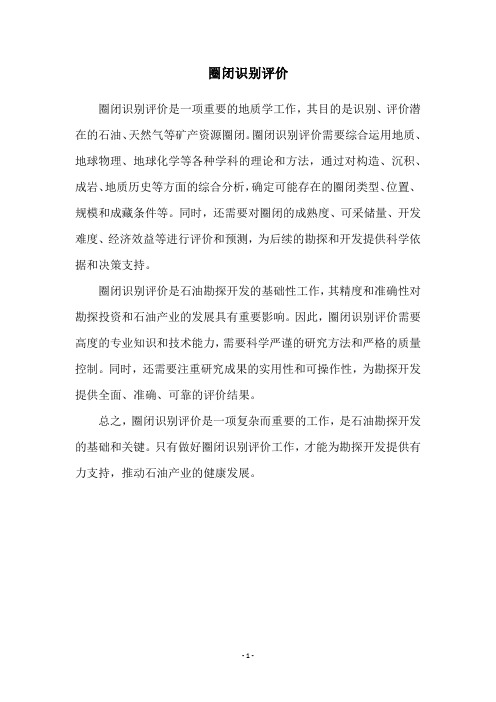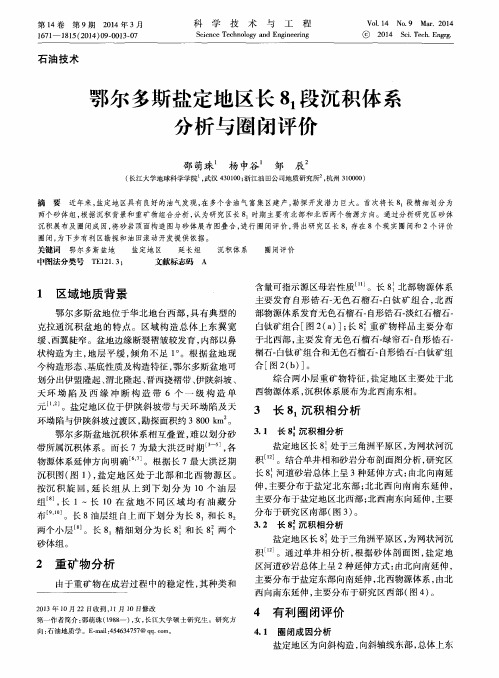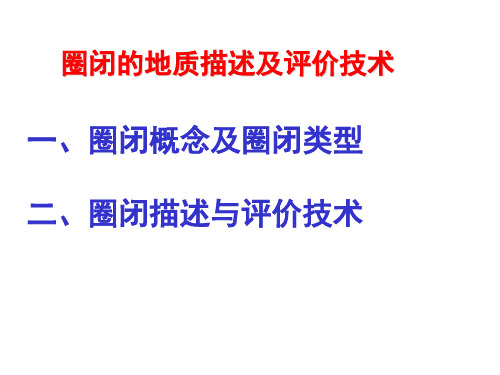圈闭评价
圈闭识别评价

圈闭识别评价
圈闭识别评价是一项重要的地质学工作,其目的是识别、评价潜在的石油、天然气等矿产资源圈闭。
圈闭识别评价需要综合运用地质、地球物理、地球化学等各种学科的理论和方法,通过对构造、沉积、成岩、地质历史等方面的综合分析,确定可能存在的圈闭类型、位置、规模和成藏条件等。
同时,还需要对圈闭的成熟度、可采储量、开发难度、经济效益等进行评价和预测,为后续的勘探和开发提供科学依据和决策支持。
圈闭识别评价是石油勘探开发的基础性工作,其精度和准确性对勘探投资和石油产业的发展具有重要影响。
因此,圈闭识别评价需要高度的专业知识和技术能力,需要科学严谨的研究方法和严格的质量控制。
同时,还需要注重研究成果的实用性和可操作性,为勘探开发提供全面、准确、可靠的评价结果。
总之,圈闭识别评价是一项复杂而重要的工作,是石油勘探开发的基础和关键。
只有做好圈闭识别评价工作,才能为勘探开发提供有力支持,推动石油产业的健康发展。
- 1 -。
潜江凹陷潜江组岩性预探圈闭评价标准研究

2 运用 效 果
运用潜 江 凹 陷潜 江 组岩性 预探 圈 闭评价模 板 , 重新 对4 个 已钻 探 的岩性 圈 闭进行 评价 ,评 价结果 6
如图3 ,其 中 I类 圈 闭 8 ,钻 探 全 部 获 得 工业 油 个 流 ,钻探 成 功率 10 0%; 1类 圈 闭2个 ,4 1 4 个获 得 工
1 . 储存 条件 .3 2
此权重 系数维持 不变 。 圈闭 幅度 :一般 情况下 ,幅度越 大 ,含油 概率 越 高 ,但从 潜江 凹陷潜 江组 岩性 圈闭 统计结 果看 , 无 明显规 律 ,获 工业 油流 圈闭幅度 平均值 为 15 9m, 见 油气显 示 圈闭幅度平 均值 为27 6m,因此 权重 系数
保存 条件 等 。
1 . 靠程 度 . 1可 2
圈闭可靠程度主要受地质 、地震 、测井三方面 资料 的影响 ,如果一个岩性圈闭若在三个及三个 以
上 方 向都有钻 井控 制 ,且小 层对 比清楚 ,沉积相 带
第 一作 者简 介 :马 胜钟 ,毕 业 于东 华理 工 学 院资 源 勘查 工程 ,工程 师 ,现从事 油气勘 探规 划研 究工 作 。
透镜 体 、 侧缘 尖灭 、物性变化 、 地 层+ 构 上 倾 尖 灭 构造 + 岩性 层 + 性 造 + 性 地 岩 岩 好 较好 一般 差
勘 探 实践表 明 ,潜江组 岩性 油藏 具有 分布 广 、
输 入值
类 型多 、油层薄 、规模小 、成 群成带 分布 的特点 。
关 键 词 :圈闭评价 ;岩性 圈闭 ;潜江组 ;潜江 凹陷
潜 江 凹陷位于江汉 盆地 中北部 ,面积 20k 2 5om 。
蒙古国勘探区块的凹陷、区带、圈闭定量评价方法

基金项目: 国家科技重大专项 “ 大庆油气持续有效发展关键技术研究与应用” (2016E⁃0202) 。
第一作者: 孙国昕, 女, 1972 年生, 博士, 高级工程师, 从事油气战略、 石油地质综合研究。
E⁃mail:sunguox@ petrochina com cn
通信作者: 赵 波, 男, 1979 年生, 硕士, 高级工程师, 从事海外区块评价、 石油地质综合研究。
3 黑龙江省致密油和泥岩油成藏研究重点实验室, 黑龙江 大庆 163712)
摘要: 海外油气勘探往往需要快速评价、 快速上钻、 快速上产, 开展地质风险评价有利于勘探决策、 规避风险。 基于蒙古
国境内 50 个凹陷、 35 个区带和 301 个圈闭资料, 借鉴海拉尔盆地、 塔木察格盆地的勘探经验, 建立了蒙古地具有相似的大地构造背景和石油地质条件, 具
技术规范 [16⁃18] , 评价参数权重系数参考邻区海拉
尔盆—塔木察格盆地、 二连盆地相关数据。
凹陷定量评价以烃源岩、 断陷结构、 构造特征
作为主要筛选因素, 建立了凹陷评价体系。
区带定量评价以烃源岩、 区带结构为基础, 考
(1 Exploration and Development Research Institute of Daqing Oilfield Co Ltd, Daqing 163712, China;
2. No 2 Oil Production Plant of Daqing Oilfield Co Ltd, Daqing 163414, China; 3 Heilongjiang Key
Laboratory of Tight Oil and Shale Oil Accumulating Research, Daqing 163712, China)
济阳坳陷地层圈闭成藏地质风险评价方法

自1 9 8 0 年 以来 , 随着济 阳坳 陷地层 油 藏勘 探力
的主要地质风险。 金3 5 井位于济 阳坳陷博兴洼陷南斜坡 金家鼻 状构造带西翼高部位 , 于2 0 0 9 年完钻全井段未见油 气显示 。首先 , 对金 3 5 井储盖组合进行分析 , 目的 层沙四段为大套火山岩储层 , 测井孑 L 隙度为 2 4 . 9 %, 渗透率为 4 1 9 x 1 0 I x m , 为中等一好储层 , 其上的沙
风 险 预 测 的评 价方 法 , 以期 实现 钻 前成 藏 风 险 的定
远离生油 中心 , 并且处于骨架砂体顶面构造分隔槽
内, 不 利 于 油 气 输 导 。金 浅 6 、 金浅 7 、 金浅 8 、 金 浅
量预测 , 为探井钻探提供参考。
地质风险及成藏主控 因素
1 . 1 地 质风 险
为明确地层 圈闭在勘探 中面临 的主要地质风 险, 需要对每 口失利探井进行地质原因剖析 。从 圈
闭成 藏的 6 要素人 手 , 利用排 除法逐步查找失利 的地质原因 , 但具体分析须与该井所在区域相同类
型或 者相邻成功井进行类 比。剖析每 口井失利地
质原 因后 , 对其进行统计 分析 , 确定钻探地层圈闭
2 0替
6
j I { j 气
地
质
采
收
卒
Vo 1 . 2 0. NI 1 _ 6 Nov . 2 0l 3
2 0 1 3 I 1 n
P e t r o l e u n 1 Ge ol o g y a nd ̄e ( ! o v e r y Ef fi c i e n c y
圈 闭探 井 , 须 对 其 顶 板 封 堵 性 进 行 评 价 。 分 析 发
鄂尔多斯盐定地区长81段沉积体系分析与圈闭评价

克拉通沉积 盆地 的特点。区域构造 总体上东翼 宽
缓、 西 翼 陡窄 。盆地 边 缘断裂 褶 皱较 发育 , 内部 以鼻 状 构造 为 主 , 地层平缓 , 倾 角不足 1 。 。根 据 盆 地 现 今 构造 形态 、 基 底性 质及 构造 特征 , 鄂 尔多 斯盆 地可
划分出伊盟隆起 、 渭北隆起 、 晋西挠褶带 、 伊陕斜坡 、 天 环 坳 陷及 西 缘 冲 断 构 造 带 6个 一 级 构 造 单 元¨ J 。盐定地 区位于伊陕斜坡带与天环坳 陷及 天 环坳陷与伊陕斜坡过渡区 , 勘探面积约 3 8 0 0 k m 。 鄂尔多斯 盆地沉积体 系相互叠置 , 难 以划分砂 带所属沉积体系。而长 7为最大洪泛 时期 , 各
主要 发 育 自形 锆 石 一 无色石榴石. 白钛矿组合 , 北 西 部 物源 体 系发育 无色 石榴 石- 自形 锆石 一 淡红 石榴 石. 白钛矿 组合 [ 图2 ( a ) ] ; 长8 重矿 物 样 品主 要分 布 于 北西 部 , 主要 发 育 无 色 石 榴 石- 绿 帘石 - 自形 锆 石一 榍石 一 白钛 矿组 合和 无色 石榴 石一 自形锆 石一 白钛 矿组 合I 图2 ( b )l 。 综 合 两 小层 重 矿 物 特征 , 盐定 地 区 主要 处 于北
第1 4卷
第 9期
2 0 1 4年 3月
高成熟探区圈闭经济评价系统及其应用

( .SN P COle xl ai n ee p et eat n, ei 0 8 8 C ia 1 I O E i l Epo t na dDvl m n D p r t B qn 102 , hn ; i f d r o o e m g
r to ai n,d v lp n n r d ci n,t i lt h u lp o e so i/ a x lr to n e eo e e o me ta d p o u t o o smu a et e f l r c s fol g se p o ain a d d v lpme t n o n ,a d t c n u tq a t a ie e o o c e auain o r p o d c u n i t c n mi v l to fta s,wh c v r o s t e d s d a t g s o r dto a v l ai n t v ih o e c me h ia v n a e f ta i n le a u to i
m t d ② Mot C r i l i ehdcnb sdt cr u sniv c r n n e an n ls f eo; h ne al s a o m to a eue a yo t e sief t du cr it a a i o o mu t n o r t ao a t y ys
勘 探 投 资 效 益 与勘 探 风 险的 优 化 分 析 , 决 了过 去 圈 闭经 济 评 价 中缺 少 风 险 分 析 和 投 资 组 合 一 体 化 评 价 的 问题 。 该 系 统 解 已经 在 胜 利 油 田应 用 , 利 油 田年 钻 预 探 井 3 胜 0余 口 , 功 率在 4 % 以上 , 果 良好 。 成 0 效 关 键 词 : 确定 性 ; 合 优 化 ; 险分 析 ; 成 熟探 区 ; 不 组 风 高 圈闭 经 济 评 价
多类型有效圈闭定量评价关键技术

多类型有效圈闭定量评价关键技术下载温馨提示:该文档是我店铺精心编制而成,希望大家下载以后,能够帮助大家解决实际的问题。
文档下载后可定制随意修改,请根据实际需要进行相应的调整和使用,谢谢!并且,本店铺为大家提供各种各样类型的实用资料,如教育随笔、日记赏析、句子摘抄、古诗大全、经典美文、话题作文、工作总结、词语解析、文案摘录、其他资料等等,如想了解不同资料格式和写法,敬请关注!Download tips: This document is carefully compiled by the editor. I hope that after you download them, they can help you solve practical problems. The document can be customized and modified after downloading, please adjust and use it according to actual needs, thank you!In addition, our shop provides you with various types of practical materials, such as educational essays, diary appreciation, sentence excerpts, ancient poems, classic articles, topic composition, work summary, word parsing, copy excerpts, other materials and so on, want to know different data formats and writing methods, please pay attention!多类型有效圈闭定量评价关键技术在油气勘探与开发领域具有重要意义。
四川元坝致密砂岩气藏水相圈闭实验评价

1
层 个
传 统 的 水 锁 没 有 明确 指 出 气 藏 初 始 含 水 饱 和 度 低 于束缚 水饱 和度 ( 或不 可 动水饱 和度 ) 这 一 前 提 条 件 ] 。 对 于水锁 损 害 , 人 们 通 常 都 是 假 定 油 气 层 的 产 纯油 或 产气 带 的初 始 水 饱 和 度就 是 束缚 水 饱 和度 , 。 所以, 水 相 圈 闭 的 概 念 与 水 锁 概 念 有 明显 的 区 别 。 水相 圈 闭与水锁 2 水 相 圈 闭 损 害 模 式 当外来 的水相 流 体 渗 入 油气 层 孔 道 后 , 会 将 储 水 相 圈闭 损 害模 式 分 三种 类 型 : 基 质 中 的 水 相 中 的油 气 推 向 储 层 深 部 , 并在油 气 / 水 界 面 形 成 一 圈 闭损 害 、 裂 缝 中 的 水 相 圈 闭 损 害 及 基 质 一 裂 缝 系 凹 向油 相 的 弯 液 面 。 由于 表面 张力 的作 用 , 任 何 弯 统 中 的 水 相 圈 闭 损 害 , 见表 1 。 表1 基 质 及 裂 缝 中 水 相 圈 闭 损 害 水 相 圈 闭 圈 闭 动 力 侵入 水扩 展 方 式 圈 闭 形式 圈 闭 过程
果
液面都 存在 一个 附加 压力 , 即产 生 毛 细 管 阻 力 , 其 大 小等 于 弯液 面两 侧 水 相 压力 和 油 气相 压 力之 差 , 并 且 可 由任 意 曲界 面 的 拉 普 拉 斯 方 程 确 定 。 欲 使 其 流 向井 筒 , 就 必 须 克 服 这 一 毛 细 管 阻 力 和 流 体 流 动 的 摩 擦 阻 力 。 若 储 层 能 量 不 能 克 服 这 一 附 加 的 毛 细 管 压力 , 就不 能把 水 的堵塞 消 除 , 最 终 影 响 储 层 的采 收 率 , 这 种损 害称 为“ 水 锁损 害 ” _ 2 ] 。 水相 圈闭是 指 在 油 气 井作 业 过程 中 , 由 于 水 基 工作 液 侵入 或生 产 中水 的 聚集 , 使 井 筒 附 近 储 层 或 裂缝 面含 水 饱和 度 S w 从 初始 含 水饱 和度 S wi 到 束 缚 水 饱和 度 S w: r r再 到 1 0 0 之 间变化 . 从 而 导 致 储 层油 相 或气 相渗 透 率 降 低 的作 用 或 现象 , 是 相 圈 闭
第4章 圈闭评价

12
10
8
6
4
2
Std. Dev = .25
Mean = .65
0
N = 60.00
.13 .25 .38 .50 .63 .75 .88 1.00
.19 .31 .44 .56 .69 .81 .94
运移距离10-50km充满系数分布
6
5
4
3
2
1
Std. Dev = .23
Mean = .60
0
的油层厚度; • 在已钻探圈闭中应通过岩心观察、测井解释、
实验室测定等方法确定,并经试油验证。 • 对未钻探的圈闭可以通过其地质变量的关系进
行预测(分布)。 • 影响油层有效厚度的主要地质因素有油藏类型、
储层沉积相等
东部第三系油层厚度一般在5-20m,占统计油田 的76%。除潜山外,滚动背斜油层厚度15-30m, 披覆背斜10-20m,断背斜6-13m。
40 30
30
20
10
Std. Dev = .22
Mean = .61
0
N = 140.00
.06 .19 .31 .44 .56 .69 .81 .94
.13 .25 .38 .50 .63 .75 .88 1.00
圈闭含油面积系数(充满系数)分布
10
20
10
Std. Dev = .19
Mean = .57
• 当采用经验分布时,则根据实测数据作出频率 分布曲线和累积分布曲线
• 对于已落实但未钻探的圈闭,其资源量计算参 数的分布可以通过类比和预测的方法得到。
第四节 圈闭资源量计算方法
三、蒙特卡罗方法计算资源量
• 蒙特卡罗方法是用统计试验方法解决实 际问题的一种数学方法,又称统计试验 方法或统计模拟方法。
圈闭评价与探井地质设计

圈闭评价与探井地质设计圈闭评价是指对地下储集空间进行定量评价,确定其中岩石层或地层单元对流体(一般指油气)的储存和运移的能力。
而探井地质设计则是指在确定钻井目标和井址的基础上,对井身设计参数进行合理选择,并确定钻井工程中的各项技术措施,以保证钻探顺利进行的过程。
圈闭评价常用的方法包括地震勘探、岩心堆取、测井和测试数据等综合分析。
其中,地震勘探是利用地下震动波的传播和反射规律,通过测定地震波的速度、方向和幅度的变化,来研究地下岩性分布、构造特征和油气圈闭的空间分布情况。
岩心堆取是指在钻井过程中取得的地层岩心样品,通过对岩心样品的物性、岩石组成和岩相等进行分析,以获得地层的物性参数和圈闭发育情况。
测井是指在钻井过程中通过各种仪器测定井深不同位置的地层电性、声波、核磁等参数,以获得井壁周围地层的物性参数和圈闭特征。
测试数据则是指通过地面或井下测试装置所获得的油气储量、油气产能和油气流动特征等参数。
圈闭评价的目的是为了确定地下储层的地质特征和储集性能,以便进一步确定油气资源的储量和生产潜力,并为油气开发提供科学依据。
圈闭评价的结果主要表现为油气圈闭形态、储层岩石性质、圈闭面积和厚度、孔隙度和渗透率、油气饱和度以及流体性质等。
探井地质设计是针对圈闭评价结果,根据勘探、采集和分析的岩心、测井和测试数据,来制定钻井策略和确定井身设计参数的过程。
探井地质设计需要考虑地层岩性、圈闭发育程度、地应力条件、地层流体性质和钻井工程的技术要求等因素。
其中,地层岩性决定了井身设计的稳定性和饱满度,圈闭发育程度影响了目标井层的准确定位和钻井过程中的井壁稳定性,地应力条件对钻井过程中的困难程度和井壁稳定性有重要影响,地层流体性质则对井壁稳定和井液选择有一定要求,钻井工程的技术要求则决定了钻井过程中各项工程操作的选择和实施。
在进行探井地质设计时,需要综合考虑以上因素,并结合勘探工程和测试数据的评价结果,以确定合理的钻井目标、井口选择、井身设计参数和钻井工程措施。
(精品)浅层河流相储层圈闭有效性评价方法、工作过程及必备图表

河流类型及划分
河流名称 低弯度
(弯曲指数≤1.5)
单河道
(分叉参数≤1)
多河道
(分叉参数>1)
平直河
(Straight Rivers)
辫状河
(Braided Rivers)
高弯度
(弯曲指数>1.5)
曲流河
(Meandering Rivers)
网状河
(Anastomosing Rivers)
注:a)河道分叉参数:平均每个蛇曲波长中河道砂坝的数目,≤1为单河道;>1为多河道。 b)弯度指数:河道长度与河谷长度的比值, ≤1.5,为低弯度河, > 1 .5为高弯度河。
同一河流的不同河段或同一河流的不同演化阶段,河流类型可以发生变化。 自然界常见的与油气勘探开发关系密切的河流类型是:曲流河、辫状河、网状河。
1、河流相沉积类型及识别标志
河流类型
• 平直河
• 曲流河
• 辫状河 • 网状河
1、河流相沉积类型及识别标志
(1)辫状河:水浅流急,发育心滩
多河道、多次分叉并汇聚成辫状。弯度小,弯度指数< 1.5,河道宽浅,宽深比值> 40。河道坡 降大,沉积物搬运量大、粒粗,河道侧向迁移快,发育心滩。多发育在山区或河流上游河段 以及冲积扇上。
1、河流相砂体构型及叠加样式
单河道的判识
废弃河道是单一河道边界的重要标志,但不 是决定性标志。因为废弃河道有很多种表现形 式,如单一曲流环形成的废弃河道,平面延伸 短,形成牛轭湖,而非整条单一河道的废弃; 平面延展性较好、可追踪对比的废弃河道才 能作为识别单一河道边界。
1、河流相砂体构型及叠加样式
砾、砂
曲流河
侧向加积
中国石油大学(北京)油气田勘探课程设计-

二、圈闭评价与井位部署
3.课程设计思路和成果
根据圈闭排队结果, 选一圈闭部署1口预探井, 简要说
设明部计署思的路依据:
圈闭综合评价排队选出最优圈闭 预探井部署原则 预计含油气的关键部位,如高点 ;
第一口井占高点, 部署在可能出油的 关键部位;
第二口井, 在一号井获得成果后, 部 署在能够控制圈闭的关键部位, 确定 是否整体含油;
一、盆地构造单元划分与含油气远景评价
3.课程设计思路和成果 设计成果: 二级构造单元: 单元8—梁寨洼槽: FII-8, FII-6, FI-5, FI-7, FIII-7, FII-7及工区边界限定。 单元13—延津洼槽: FI-5, FII-7, FIII-7, FI-7限定。 单元11—白沙断裂构造带: FII-12, FIII-3, FII-4, FII-5, FI-1限定。 单元12—太平镇断裂构造带: FII-9, FI- 8, FIII-9, FII-8, FIII-10, F111-3限定。 单元14—鲁岗断裂构造带: FI-6, FI-3 限定。
3. 课程设计思路和成果 4. 为对圈闭进行地质评价,需确定圈闭的相关参数。请根据所给条件,读取不同圈闭的
相关参数填写到表4-1,其同圈闭配套条件的参数相同并已给出。之后,根据下式计算 不同圈闭的含油气概率,参数标准见表4-2。
5. 设计思路: 6. 依次次为每一个圈闭依据给分标准进行打分(geomap图件) 7. 作业一的圈闭图件 8. 3.
一、盆地构造单元划分与含油气远景评价
3. 课程设计思路和成果 4. 根据构造单元划分结果,结合整个渤海湾盆地的含油气层系分布特点,以及该区的钻
探情况,预测有利的油气远带
5. 设计思路: 6. 渤海湾盆地区域地质概况 7. 渤海湾盆地地层发育特征 8. 研究区的油气远景区带
油气圈闭综合评价程序

油气 圈 闭评价 的根本 目的在 于为 多个 圈闭 目标
的优 选决 策 提 供 依据 _. 5 其结 果 可 以有 效 地 为 油气 ] 的增储 上产 提 供钻 探 目标 . 进 区域 油气 勘 探 的升 推
级 和深化 。现代 油气 圈闭评 价在 油气勘 探 中发 挥着
型, 落实 圈 闭的形 态 、 合面 积 、 合 高度 等 圈闭 基 闭 闭
现 阶段 油气 勘 探具 有 系统 工程 的 特点 。 细 精
收 稿 日期 :0 9 1 — 8 2o — 2 0
同勘探 程度 的 圈闭含 油气性 控制 因素 、资源量参 数 研 究 、 济评 价 的控 制 因素 , 行层 次 分 解之 后 。 经 进 最
作 者 简介 : 国 民 (9 4 )男 , 西安 康 人 , 师 , 士 后 , 究 方 向为 石 油地 质 勘 探 。 陈 17 一 , 陕 讲 博 研
・
1 ・ 6
陈 国民 : 气 圈闭综合评 价程序 油
底 层 因素( 即评 价 参 数 ) 能够 获 得 的数据 或 事 实 。 是 所 以 . 性评 价 需要 根 据各 评 价 内容 具 有 系统 性 和 定
层次 性 的特 点[, 价参 数体 系构 建 、 8评 2 评价 标 准 的制
() 3 定性 评 价 。 通过 定性研 究 分析不 同类 型和不
越 来越 大 的作用 . 实践 中 随之 不 断发 展充 实 了 圈 闭 评价 技术 方法 ] 目前 , 于油气 勘探 圈 闭评价 程 。 关
序 、 织结 构和要 点 的研 究并 不多 。 组
1 圈 闭综 合 评 价 阶 段 划分
勘 探和综 合勘 探为 其显著 特征 。一个 典型 的相对 比 较 完整 的 圈闭评价 过程 ,是在 区域综 合地质 研究 的
章圈闭描述和评价

3、圈闭可靠性评价
(1)影响圈闭可靠性的主要因素 1)圈闭控制程度
圈闭控制程度决定于圈闭规模与测网密度之间 的关系,是影响圈闭成图精度的重要因素。一个探 区内由于勘探工作量不够,测网稀,造成高点不落 实和钻探落空是屡见不鲜的。
3、圈闭可靠性评价 (1)影响圈闭可靠性的主要因素
2)地震资料质量
地震资料的质量表现为分辨率、信噪比、闭合 差、地震反射层位、断点与地层尖灭点显示等特征, 受资料采集、资料处理等多方面因素的影响。
二、圈闭评价与描述技术 1、圈闭评价概念
概念:圈闭评价与描述是以现代油气成
藏理论为依据,以计算机为手段,以勘探数 据库为依托,充分利用地面物化探资料、井 筒资料和综合研究成果,进行圈闭成藏条件 的系统分析与和基本特征的综合描述。
二、圈闭评价与描述技术 2、描述的内容
•圈闭落实的可靠性评价 •圈闭成藏地质有效性评价 •圈闭资源量评价 •圈闭经济评价 •圈闭综合评价与优选
5、圈闭资源量估算
(3)估算方法
2)统计模拟法
它适合与勘探程度比较高的探区,各种参数的分 布模型已知,它利用随机模拟技术,由计算机自动从 变量参数中随机抽取数据进行模拟,最终得到不同置 信水平下的资源量概率分布曲线。指出不同概率下油 气资源量的可能规模,适合于对资源量进行评价风险。 蒙特卡罗法计算圈闭资源量实现过程 ①确定估算参数,选择评价模型;②将参数分类; ③确定变量参数的概率分布;④统计模拟实现。
5、圈闭资源量估算
影响圈闭资源量估算的因素很多,归纳起来有三个方面, 即估算模型、参数取值、估算方法,我们称之为圈闭资源量估 算的三要素。
(1)估算模型
圈闭资源量估算模型即通常所说的计算公式。目前 所用的估算模型有很多种,最常用也是最重要的是容 积法。
三合村地区东营组剥蚀地层圈闭评价方法

三合村洼陷地层圈闭具有倾角缓、隔层薄、含油高度低的特点,地层圈闭有效性评价是影响井位钻探成功率的关键。
勘探实践表明圈闭有效性主要受剥蚀点的准确识别、顶部盖层条件以及东营组内部隔层条件,本文旨在对三合村地区东营组剥蚀地层圈闭有效性评价方法进行总结,对滩海等地区地层圈闭的勘探部署中起到借鉴作用。
三合村洼陷位于沾化凹陷南部,是该区近两年的勘探热点。
该洼陷东营组主要沉积相为三角洲相,沉积物颗粒较细,主要为砂岩,粉细砂岩和泥岩,水缓坡带储层广泛发育,自北往南储层逐渐减薄尖灭,沿陈家庄凸起北坡横向上变化不大,储层条件比较落实。
一、剥蚀点准确描述方法剥蚀地层靠近剥蚀点时,地层逐渐减薄,不可避免地产生薄层干涉效应,因此不整合面对剥蚀点位置的反应会出现一定的偏差。
前人对此做过大量的研究,如苏朝光等依据地层剥蚀几何模型提出了夹角外推的方法,进一步提高剥蚀点描述的精度。
本区剥蚀圈闭除剥蚀层本身的影响之外,上覆地层也存在较大差异,从已钻井的情况来看,大致有泥岩、灰岩、砂岩以及砂泥岩薄互层四种盖层发育模式,增加了剥蚀点地震反射的复杂性,单纯利用夹角外推手段对不同盖层条件的圈闭剥蚀点识别效果仍有一定的多解性。
本次选用了NEWS软件的谐波拓频方法进行解释性处理,是根据地震层序体模型,通过连续分小波变换将地震信号分解在规定的主频范围内白化,按倍频分别乘在高频端和低频端进行延拓,得到延拓谐波,加强目标层调谐频率、加强地震信号中有效反射波的高频成分的地震处理技术,可有效提高地震识别能力。
在此基础上,结合瞬时相位剖面、视极性剖面等剖面,利用其连续性增强的特点,更容易把握剥蚀点。
二、盖层、隔夹层描述与评价1.盖层地震预测描述。
不整合上覆盖层条件可由不整合面上部反射波峰的反射振幅强弱以及频率、波形属性反应。
开取合适的时窗提取振幅、频率、波形三大类属性,进行多属性融合,预测盖层平面分布相带。
在井位控制下进行多属性拟合,构建对盖层变化反映更加敏感的复合属性进行盖层分布相带描述。
中石化圈闭评价与技术规范 解读_77

其他圈闭(如:水动力、沥青封堵型等圈闭)。
3、复合圈闭
构造-岩性圈闭(如:背斜-岩性、断层-岩性等圈闭); 构造-地层圈闭(如:背斜—地层、断层—地层等圈闭); 构造-流体圈闭(如:断层-水动力等圈闭)。
一、 相关名词解释与说明
22.22
20
10
10
0 背斜 断背斜 断块
岩性
地层
0 复合
圈闭总数(个)
工业油气圈闭(个)
圈闭钻探成功率(%)
不同类型圈闭成功率
构造 岩性地层
复合
51.06% 42.42% 41.38%
不同类型圈闭钻探成功率不同
圈闭数(个) 圈闭钻探成功率(%)
二、主要问题
(2)不同地区圈闭的成藏风险分析欠深入 ➢ 不同地区成藏关键因素分析针对性不强; ➢ 圈闭含油气性评价模式化,关键因素风险分析重视不够。 ➢ 圈闭资源量的计算问题
代表公司
埃克森、壳牌、雪佛龙、BP、中石化、中石油、中海油
不同油公司圈闭含油气概率评价参数体系及表征方法
公司 Chevron
Exxson
马来西亚 石油公司
中石油 中海油
概率因子
参数体系
圈闭、 a.圈闭:圈闭的存在、特征与盖层的完整性 烃源岩、 b.烃源岩:烃源的存在、质量、成熟度
储层、 c.储层:储层的存在和质量 匹配 d.匹配:运移通道、时间匹配 烃源岩、 a.烃源岩:有机质数量、类型、成熟度 储层、 b.储层:厚度、断层、孔隙度 圈闭、 c.圈闭:存在、类型 运移、 d.运移:输导层 时间匹配 e.时间配置
m n 岩性圈闭
浊积Pg砂体 圈闭(滩坝P砂ij体a圈ij 闭)
油气圈闭评价计算机模拟研究

圈 闭评 价和 圈 闭 预探 , 现 为 理论 和 实 践 范 畴 世 纪 9 表 0年代 由于 钻井 和地震 等 技术 的进 步 , 量 的 大
气勘探 需要 ; 闭评 价 工 作 的认 同正 是 在 日趋 复 杂 圈
的勘探 形势 和艰难 的探索 中逐 渐形 成 的。 目前流 行 技 界探 索 的难 点 问题 之 一 ; 同时 , 由于含 油气 圈 闭深 的圈 闭评 价 技 术 方 法 是 以现 代 油 气 成 藏 理 论 为 指 埋地下 , 对其的认识和评价只能利用有效 的间接信 导, 以勘 探数据 库为依 托 , 以计算 机 技术 为 主要 支撑 息 , 闭地 质情 况 的复杂 性 、 多 评价 因素 的不确 定 圈 众
软件研制 , 最后 实现 了以计 算机 为平 台进行 圈闭综合评价 与优 选。利 用先进的计 算机技 术和通 信技术 来模 拟 圈闭综 合评价过程 , 可以达到硬件 、 软件、 评价决 策者 以及评价信 息的快速互 动, 而为科 学的勘探 目标 决策提 供及 时的、 从 智
能性 的定性及定量 的参考 , 保证 了目标 决策的科 学性和 可靠性 。
的一 对矛盾 ; 闭评 价 必 然 服从 和 服务 于 现 实 的油 圈
1 研 究现 状
早 期 的圈 闭评 价 研究肇 始 于 2 纪 上半 叶 ,0 O世 2
圈闭被 勘探 发 现 , 如何 对 其 进 行 有 效 地 管 理 和评 价 以促进 油气 勘 探 的进 一 步 升 级 I , 直 是 石 油 科 4 一
关键词 :圈闭评 价; 科学决策 ; 综合评价 ; 价模 型 ; 评 计算机模拟
中 图分 类 号 : E 2 T l2 文 献标 识码 : A D I 1 .8 3ji n 1 0— 64 2 0 .5 0 9 s
- 1、下载文档前请自行甄别文档内容的完整性,平台不提供额外的编辑、内容补充、找答案等附加服务。
- 2、"仅部分预览"的文档,不可在线预览部分如存在完整性等问题,可反馈申请退款(可完整预览的文档不适用该条件!)。
- 3、如文档侵犯您的权益,请联系客服反馈,我们会尽快为您处理(人工客服工作时间:9:00-18:30)。
Source Rocks
Source rocks are fine grained shales or carbonate rocks containing a certain amount of organic matter.
Source Rock -- Shale
Experience have shown that a shale must contain at least 5% organic matter or 0.5 % total organic carbon to be able to generate sufficient amount of petroleum to be classified as a source rock.
Kerogen Type -- Ⅲ
It is normally derived from higher landplants that often have been exposed to oxidation on land before deposition. Plant remains can often be identified in type Ⅲ kerogen. The potential for generating oil is very low, but it may have a good potential for generating gas.
Evaluating Quality Using Rock-Eval HI/OI
Type Ⅰ has the highest hydrogen content; type Ⅲ, the lowest. To determine the kerogen type present in a source rock, plot the hydrogen and oxygen indices on a modified Van Krevlen diagram.
Kerogen Type -- Ⅰ
It is formed by accumulation of algal matter, dominantly from fresh water environments. This type of kerogen has a good potential for generating oil and gas.
Trap Evaluation
Accumulation of petroleum in a trap = Source rock × Maturation × Migration × Reservoir rock × Trap (including seal) × Timing
Evaluating Source Rock Richness-TOC Generation Potential Poor Fair Good Very Good Wt % TOC, Shales 0.0 - 0.5 0.5 - 1.0 1.0 - 2.0 2.0 - 5.0 Wt % TOC, Carbonates 0.0 - 0.2 0.2 - 0.5 0.5 - 1.0 1.0 - 2.0
Evaluating Source Rock Richness-Pyrolysis
During the analysis, the hydrocarbons already present in the sample are volatized at a moderate temperatures.
Trap Evaluation
Trap Evaluation
A trap consists of a geometric arrangements of permeable (reservoir) and less-permeable (seal) rocks which, when combined with the physical and chemical properties of subsurface fluids, can allow hydrocarbon to accumulate.
Kerogen Type -- Ⅱ
Type Ⅱ kerogen is formed by the accumulation of organic matter from phytoplancton, zooplancton, and bacteria in reducing conditions in marine environment. It has a good potential for generating oil. The majority of the large oilfields in the world have source rocks with type Ⅱ kerogen.
Trap evaluation is to estimate the probability of discovery prior to drilling of a mapped prospect.
Trap Evaluation
Accumulation of petroleum in a trap = Source rock × Maturation × Migration × Reservoir rock × Trap (including seal) × Timing
TOC % =[0.082(S1+S2)+S4]/10.
Evaluating Source Rock Richness-Pyrolysis
Evaluating Source Rock Quality Type of Organic Matter
Oil is mainly generated from organic matter derived from microorganism living in aquatic environments, while organic matter that comes from terrestrial plants mainly generate gas.
Kerogen is the most important part because by thermal alteration it will convert to petroleum.
Molecular Structure of Kerogen
Kerogen Type -- Ⅰ
Type Ⅰkerogen have a high H/C (>1.5) and low O/C ratio. It consists mainly of aliphatic chains and the number of nuclei is low.
Source Rock -- Carbonate
For a yet unknown reason, 3% organic matter or 0.3% total organic carbon is enough for a carbonate rock to be classified as a source rock.
Kerogen Type -- Ⅲ
Type Ⅲ kerogen has low H/C (0.7--1.0) and a high O/C ratio. It contains a large number of nuclei and only minor amounts of aliphatic chains.
The amount of hydrocarbons are measured and recorded as a peak known as S1.
Evaluating Source Rock Richness-Pyrolysis
Next pyrolyzed is the kerogen present in the sample, which generates hydrocarbons and hydrocarbon-like compounds (recorded as the S2 peak), CO2, and water.
Kerogen
The transformed organic matter consists of a mixture of complex organic compounds. A small part can be extracted by organic solvents and is called bitumen. The rest, which is the major part, is not extractable in organic solvents and is called kerogen.
Kerogen Type
Kerogen Quality
Kerogen Type Predominant Hydrocarbon Potential Amount of Hydrogen Typical Depositional Environment
Ⅰ
Oil prone
Abundant
Lacustrine
Ⅱ
Ⅲ Ⅳ
Oil and gas prone
Gas prone Neither (primarily composed of vitrinite or inert material)
Moderate
Small None
Marine
Terrestrial Terrestrial(?)
Evaluating Quality Using Rock-Eval HI/OI
HI = S2 (mg/g)/%TOC×100
OI = S3 (mg/g)/%TOC×100
Evaluating Quality Using Rock-Eval HI/OI
